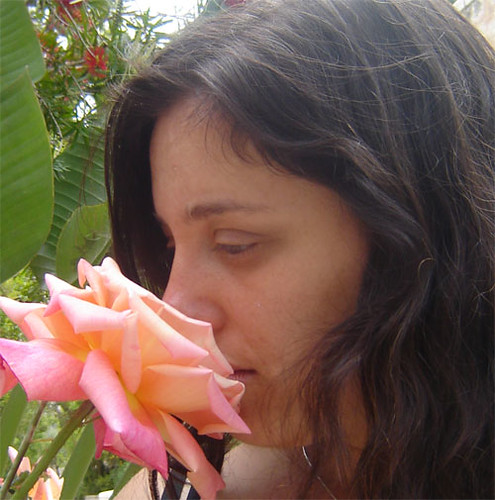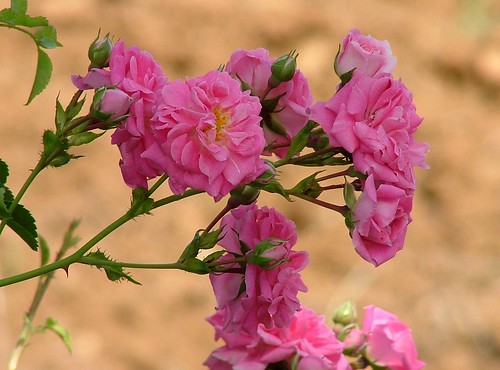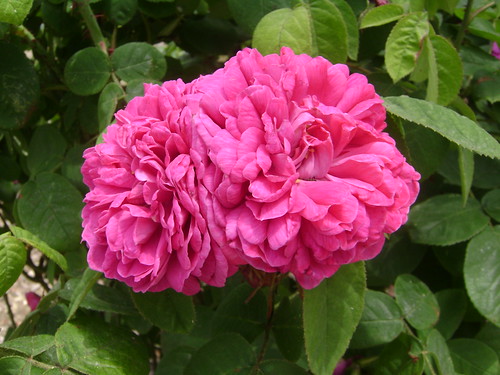Stop And Smell The Roses

Self Definition, originally uploaded by Ayala Moriel.
How
did the rose
ever open its heart
and give to this world all of its beauty?
It felt the encouragement of light against its being,
otherwise we all remain too
frightened.
- Hafiz
The beauty of rose unfurls its spiral-shaped blossom, unfolding each petal as it progresses. There always seems to be more depth to the perfume of rose. Which is why when we stop to smell the roses, we tend to take long, deep breaths... There always seems more to it in the next inhale, and the next one... Just a short whiff won't cut it!
It is impossible to imagine what perfumery would be like without roses. The beauty of rose essences - both the attar (rose otto) and absolutes add an irreplaceable quality to a perfume, making it round and harmonious.
Part of the appeal of roses is their complexity. Rose is one of the most complex botanical essences, of which 540 elements were identified; yet it is still inimitable by means of synthetics. But it is also rose’s complexity that makes it one of the most challenging natural raw materials to work with in perfumery.
As discussed in the previous article, the roses most used in perfumery are the Rosa damascena and Rosa centifolia. Rosa damascena is mostly steam distilled to produce Rose Otto – the best of which comes from Iran (but is hardly ever imported anywhere out of the Arab world). Persian rosweater is used during the prayers in the Hadj in Mecca to cleanse the Kaaba.
Like many natural raw materials, rose essences olfactory profile varies greatly depending on their geographical. On the whole, some generic observations can be made: rose has a typical “rosy” scent, which characterizes this unique flower essence, and is mostly derived from the high percentage of citronellol and geraniol, as well as phenyl ethyl alcohol (in the absolute), which gives the fresh-petal note. In addition, there is citrusy aspect (from citral), and a slightly spicy aspect, from eugenol (which is also present in cloves and allspice, for example). It also contains many trace elements, which vary from species to species (i.e.: ionone, which is much stronger in Tea roses). On a scent strip, rose begins as a fruity, rosy, full-bodied, even wine-like or honey-like, and softens as it dries down, sometimes showing some green aspects (I suspect this is because the flowers’ sepals and base are also extracted in the solvent). It dries down into a woody and even slightly animalic note. Rose is a heart note, but very long lasting, and depending on the context of how it is blended, it may even act as a base note.
Bulgaria’s Valley of Roses produces the finest Rosa damascena attar and rosewataer. White rose bushes (Rosa alba) grow at the edges of these fields. After Bulgarian rose otto, the next best quality is of Anatolian rose otto (from Turkey). The Bulgarian otto tends to be more light, and to me smells more true to the fresh flower. Turkish rose otto is heavier, more full bodied and with a certain wine-like and even slightly earthy qualities. Other locals of rosa damascena of lesser qualities come from Russia, India, Pakistan and Uzbekistan. The Indian roses have a peculiar off note that makes them completely different than anywhere else in the world. It’s as if they take with them some of the earthy qualities of the Indian soil. This kind of rose has, of course, its own beauty, but is less desirable for Western perfumery purposes. It lends itself beautifully to more exotic blends, with an Asian or Indian theme.
It’s important to note, that producing the steam distilled essential oil does not capture the entire scent of the rose. The important molecule phenylethyl alcohol, for example, remains in the distillate water, and is mostly responsible for the fine aroma of rosewater.
Rose absolute, from solvent extraction, is primarily extracted from Rosa centifolia, (Grasse in France and Morocco are the major growers), and only to a lesser extent from Damascus roses in Bulgaria and Turkey. The absolute captures a fuller spectrum of the living rose. It must be noted, that the rose absolute is so extremely concentrated, it is best to dilute it down to as low as 10% to unfold and release the aroma of fresh rose petals, and fully understand this raw material.
Similarly, too high a proportion of rose in a formula can pose challenges. It can make the perfume too dense and rich. This is particularly true for purely natural perfumes, which are always in danger of becoming cluttered or too dense. Rose is used in all fragrance categories:
In classic colognes, it is used in a very low proportion along with citrus and herbs for a refreshing and light citrus fragrance.
In Orientals, rose has a central role in harmonizing and rounding off the composition, bridging between the rich resinous base notes and the light citrus or exotic spice notes at the top. Rose will have a similar role of bridging and rounding in Chypres. In both cases, rose lends itself readily to being the star of the show, in a rose-dominated Oriental (i.e.: Parfum Sacre) or Chypre (Nuit de Noel). And of course – it is essential in floral bouquets and is the most popular soliflore of the all.
According to Shiseido’s research, fragrant roses can be classified to 6 different categories – all of which seem to be difficult to describe without reference to other roses:
Damask Classic
Combination of the “strong and sweet Rosa centifolia with the exuberant scent of Rosa gallica”
Damask Modern
Similar to the above, but with “more passionate sophisticated scent”.
Scent of Tea
As mentioned earlier, the violet and tea-like qualities of China roses added to the damask or centifolia roses, added a more delicate, graceful, and somewhat reminiscent of tea aroma to hybrid tea roses.
Fruity
Damask Classic or Tea Rose with the added nuances of fruit, such as peach, apricot, apple, raspberry, etc.
Blue Scent
Charcterisics of both damask and tea roses.
Spicy Scent
Damask Classic, with accentuated cloves scent (from eugenol).

rosa_rugosa_3_coin_de_jardin, originally uploaded by JD-roud.
Similarly, just as there are many rose breeds, with various colours, shapes, sizes and odours, even rose-dominated perfumes have a lot of variety within them. Let’s explore some of the main ones:
Fresh Rose
These rose perfumes have a very light, almost realistic rosiness, and are as close as could be to the fresh living flower.
i.e.: Tea Rose, Evelyn Rose, Stella, Rosebud
Green Rose
Often a nearly Chypre type, these green florals excude the briskness of crushed leaves, grass and rose petals.
i.e.: Ivoire, Kelly Caleche, l'Ombre dans l'Eau, No. 19, Grin
Fruity Rose
Fruity, full-bodied, sometimes wine-like, and at times with added fruity notes such as peach, apricot, apple, etc.
i.e.: Grand Amour, Spring Flower
Powdery-Sweet Rose
Roses paired with violet or orris. Soft, powdery and often sweet with a somewhat old-fashioned air to them. Vanilla is also not a rare thing to find in this rosy category.
i.e.: Paris, Bvlgari, Lipstick Rose, N'Aimez Que Mois, Cabaret
Big Abstract Rose
Modern interpretations of the rose have painted it with large strokes and less components than in old fashioned rose formulas, making them less realistic, but not any less romantic, despite their boldness
i.e.: Nahema, Tresor
Animalic Rose
Rose with an intentional animalic base makes it… well, a little naughty. Civet and musk are particularly effective to that extent.
i.e.: Joy, Agent Provocateur, Megumi
Earthy Rose
When paired with earthy notes, such as patchouli, rose grows bigger and stronger; as if on a fertile soil that allows her to fully develop luscious petals. Notes such as patchouli are the most important to that effect and this genre has become quite popular now (especially with the new restrictions on oakmoss). Of particular interest is Alexander McQueen's Kingdom, in which the cumin note adds a sensual earthiness.
i.e.: Kindgom, Midnight Poison, Philtre d'Amour, Taurus
Musky Rose
Rose with a light, musky base. These can often be also quite powdery.
i.e.: Tocade, Poussiere de Rose
Dark Rose
Often from the Chypre family, dark roses are haunting, mysterious and full of depth.
Dark rose impression is often achieved by pairing it with mosses, spices and animalic notes.
i.e.: Nuit de Noel, Black Rose, Song of Songs
Spicy Rose
Roses have always been paired with spices, both medicinally and for culinary purposes. It is not surprising, than, to find that roses go well with spice in perfumes as well. Spicy roses don’t necessarily need to smell like potpourri. Some are the most luxurious rose perfumes that I’ve ever came by.
i.e.: Parfum Sacré, Ta'if, Fête d'Hiver, Roses et Chocolat


